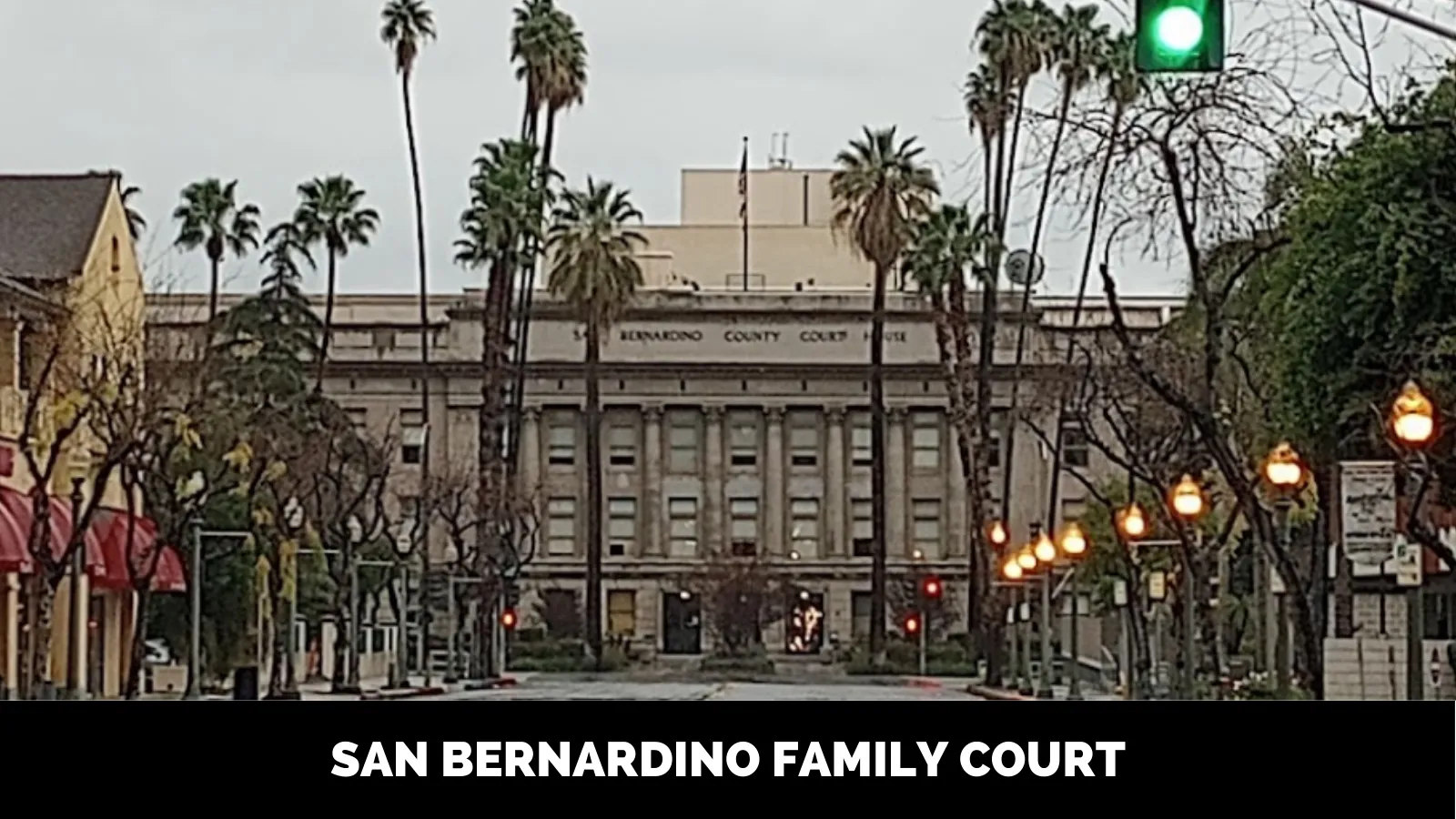San Bernardino Family Court
Time
Working Hours:
Monday:
8 am–4 pm Tuesday:
8 am–4 pm
Wednesday:
8 am–4 pm
Thursday:
8 am–4 pm
Friday:
8 am–4 pm
Saturday: closed
Sunday: closed
Connect with a Attorney
Introduction to San Bernardino Family Court
San Bernardino Family Court is a government body that hears a variety of family-related cases. The court is located in San Bernardino, California, and has a long history of serving the local community. The purpose of the court is to resolve disputes and provide justice to families in the area.
Types of cases heard at San Bernardino Family Court
San Bernardino Family Court handles several types of cases that involve families and relationships. Some of the most common cases heard by the court include:
Divorce cases
Divorce cases are the most common type of case heard by San Bernardino Family Court. These cases involve the termination of a marriage and the division of assets and liabilities between the parties.
Child custody cases
Child custody cases are also frequently heard by the court. These cases determine which parent will have legal and physical custody of the children.
Domestic violence cases
Domestic violence cases are heard by the court to protect victims from abuse. These cases may involve restraining orders, custody battles, and other related issues.
Adoption cases
Adoption cases are heard by San Bernardino Family Court to formalize the adoption process. These cases involve the legal transfer of parental rights from one person to another.
How to file a case at San Bernardino Family Court
If you need to file a case at San Bernardino Family Court, there are several steps you need to follow.
Requirements for filing a case
Before you can file a case at San Bernardino Family Court, you must meet certain requirements. These requirements vary depending on the type of case you are filing, but generally, you must be a resident of the area and have a valid reason for filing a case.
How to initiate the process
To initiate the process of filing a case at San Bernardino Family Court , you will need to gather all necessary information and documents. This may include financial records, medical records, and other relevant evidence. Once you have all the necessary information, you can file your case by submitting the appropriate forms to the court clerk.
Representing yourself in court
While it is possible to represent yourself in court, it is not always the best option. There are advantages and disadvantages to self-representation, and it is important to consider these before making a decision.
Advantages and disadvantages
The main advantage of representing yourself in court is that it can be less expensive than hiring an attorney. However, self-representation can also be risky, as you may not have the legal knowledge or skills necessary to effectively defend your case.
Preparing for court
If you decide to represent yourself in court, it is important to prepare thoroughly. This may include researching the law, gathering evidence, and practicing your arguments. You should also familiarize yourself with court procedures and rules to ensure that your case runs smoothly.
Hiring an attorney
Hiring an attorney can be beneficial in many cases. An attorney can provide legal advice, represent you in court, and help you navigate the legal system.
Benefits of having an attorney
Having an attorney can provide several benefits, including:
- Legal expertise: Attorneys have the knowledge and experience necessary to effectively represent you in court.
- Objectivity: Attorneys can provide an objective perspective on your case, which can be helpful in negotiations and settlements.
- Representation in court: An attorney can represent you in court and ensure that your rights are protected.
Finding an attorney
When searching for an attorney, it is important to find one who specializes in family law. You can find an attorney by asking for referrals from friends or family, searching online, or contacting your local bar association.
Court procedures
Once you have filed your case, you will need to follow court procedures to resolve your dispute.
Scheduling and attending court dates
Once your case has been filed, the court will schedule court dates. You must attend these court dates to ensure that your case moves forward.
Preparing for court
Before attending court, it is important to prepare thoroughly. This may include gathering evidence, practicing your arguments, and familiarizing yourself with court procedures.
Evidence in court
In order to prove your case, you will need to present evidence in court.
Types of evidence
There are several types of evidence that can be presented in court, including:
- Documentary evidence: This may include financial records, medical records, and other written evidence.
- Testimonial evidence: This includes witness testimony and other statements made by people with direct knowledge of the case.
How to present evidence
When presenting evidence in court, it is important to follow proper procedures. This may include submitting evidence to the court in advance, providing copies to the other party, and following rules for introducing evidence during the trial.
Mediation in San Bernardino Family Court
Mediation is a process that can be used to resolve disputes without going to trial.
What is mediation
Mediation is a process in which a neutral third party, called a mediator, helps the parties involved in a dispute reach a mutually agreed-upon resolution.
Advantages of mediation
There are several advantages to using mediation to resolve disputes, including:
- Cost: Mediation is often less expensive than going to trial.
- Speed: Mediation can be faster than going to trial.
- Control: Mediation allows the parties to have control over the outcome of the dispute, rather than leaving it up to a judge or jury.
- Confidentiality: Mediation is often confidential, meaning that the proceedings are not made public.
Mediation process
The mediation process typically involves the following steps:
- The parties agree to participate in mediation.
- The mediator is chosen and the mediation process is scheduled.
- The parties attend the mediation session and discuss the dispute with the mediator.
- The mediator helps the parties reach a mutually agreed-upon resolution.
- If a resolution is reached, it is put in writing and signed by the parties.
Final verdict and appeals
Once the court has heard all the evidence and arguments, a final verdict will be reached.
How the verdict is reached
The verdict is typically reached by the judge or a jury after considering all the evidence and arguments presented in court.
Appealing the verdict
If you are dissatisfied with the verdict, you may have the right to appeal. An appeal is a request for a higher court to review the case and determine if the verdict was correct.
The role of the San Bernardino Family Court judge
The judge is a key player in the court process, responsible for ensuring that the trial is fair and that the law is followed.
Qualifications of a Judge
To become a judge in San Bernardino Family Court, an individual must meet certain qualifications, including:
- A law degree and legal experience
- A good reputation and character
- Approval by the state judiciary committee
Responsibilities of a judge
The judge’s responsibilities include:
- Overseeing the trial process
- Ensuring that the law is followed
- Making rulings on legal issues
- Determining the verdict
The role of the San Bernardino Family Court clerk
The court clerk is responsible for maintaining the records of the court and assisting the parties involved in a case.
Qualifications of a clerk
To become a court clerk, an individual must have a high school diploma or equivalent and pass a written examination.
Responsibilities of a clerk
The court clerk’s responsibilities include:
- Maintaining court records
- Assisting the parties involved in a case
- Collecting and disbursing funds
- Preparing court documents
The role of court-appointed professionals
In some cases, the court may appoint professionals to assist in the resolution of a dispute.
Guardians ad litem
A guardian ad litem is a court-appointed professional who represents the best interests of a child in a custody or abuse case.
Mediators
Mediators are court-appointed professionals who assist the parties in a dispute to reach a mutually agreed-upon resolution.
San Bernardino Family Court services
San Bernardino Family Court offers several services to assist the parties involved in a case.
Self-help center
The self-help center provides information and assistance to individuals who are representing themselves in court.
Child support services
Child support services assist in the collection and distribution of child support payments.
San Bernardino Family Court Case Lookup
If you are looking for information about a case that is currently being heard or has been heard in the past at San Bernardino Family Court, you can use the court’s case lookup system. The case lookup system allows you to search for cases by case number, party name, or attorney name. You can access the case lookup system on the San Bernardino Family Court website.
San Bernardino Family Court Phone Number
If you need to contact San Bernardino Family Court, you can call the court’s main phone number. The phone number can be found on the court’s website or by searching online. When calling the court, have your case number or party name ready to ensure that you are connected with the correct department.
San Bernardino Family Court Calendar
The San Bernardino Family Court calendar is a schedule of upcoming court dates and events. The calendar can be found on the court’s website and is updated regularly. The calendar is a useful tool for keeping track of your court dates and ensuring that you are prepared for your court appearance.
San Bernardino Family Court Forms
San Bernardino Family Court provides a variety of forms for individuals who need to file a case or respond to a case that has been filed against them. The forms can be found on the court’s website and include divorce forms, child custody forms, domestic violence forms, and adoption forms, among others.
San Bernardino Family Court Address
The address of San Bernardino Family Court is located on the court’s website or can be found by searching online. The court’s physical address is where you can go to file a case, attend court dates, or access other court services.
San Bernardino County Court Records Smart Search
The San Bernardino County Court Records Smart Search is a database that allows you to search for court records in San Bernardino County. The database can be accessed on the San Bernardino County website and can be searched by case number, party name, or attorney name.
San Bernardino Divorce Forms
San Bernardino Family Court provides divorce forms for individuals who need to file for divorce. The divorce forms can be found on the court’s website and include forms for initiating the divorce process, responding to a divorce petition, and finalizing the divorce. It is important to carefully review and complete the forms to ensure that your divorce case is handled correctly.
Conclusion
San Bernardino Family Court is a valuable resource for families in the area. Whether you are involved in a divorce case, child custody case, or any other type of family-related dispute, the court can help you resolve your dispute and provide justice.
FAQs about San Bernardino Family Court
- What types of cases does San Bernardino Family Court hear?
San Bernardino Family Court hears a variety of family-related cases, including divorce cases, child custody cases, domestic violence cases, and adoption cases.
- Can I represent myself in court?
Yes, you can represent yourself in court, but it is not always the best option. Consider the advantages and disadvantages of self-representation and consider hiring an attorney if necessary.
- What is the role of the judge in San Bernardino Family Court?
The judge in San Bernardino Family Court is responsible for overseeing the trial process, ensuring that the law is followed, making rulings on legal issues, and determining the verdict.
- What is mediation and how does it work in San Bernardino Family Court?
Mediation is a process in which a neutral third party helps the parties involved in a dispute reach a mutually agreed-upon resolution. In San Bernardino Family Court, mediation is used to resolve disputes without going to trial.
- Can I appeal the verdict in San Bernardino Family Court?
Yes, if you are dissatisfied with the verdict in San Bernardino Family Court, you may have the right to appeal. An appeal is a request for a higher court to review the case and determine if the verdict was correct.






